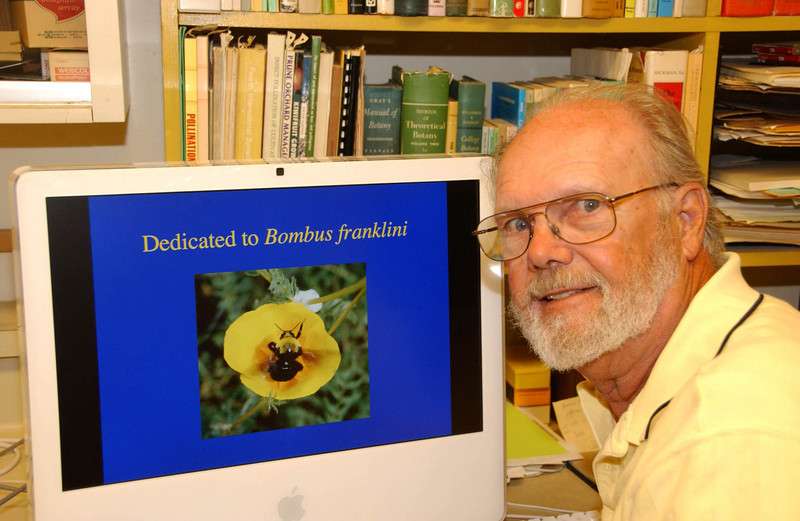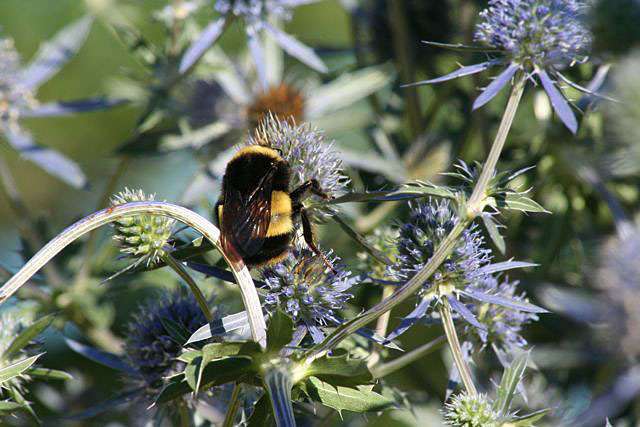Daily Kos: State of the Nation
U.S Bumble bee Population Implodes, Drops 96%
by FishOutofWater
Tue Jan 04, 2011 at 06:58:34 PM PST
Pollinators of food crops and wild plants are in near catastrophic decline.
Colony collapse disorder has decimated honey bee populations. Now a census of bumble bees shows a 96% population collapseof 4 major U.S. species of bumble bees.
The abundance of four common species of bumblebee in the US has dropped by 96% in just the past few decades, according to the most comprehensive national census of the insects.
- FishOutofWater's diary :: ::
Colony Collapse Disorder, affecting honeybees and the pollination of major food crops, has been well reported for several years. Bumble bees are vital to the productivity and reproduction of many food crops and many wild plants. Tomatoes depend on bumble bees for effective pollination. The collapse of bumble bee populations has been suspected by biologists, but has not been reported because of a lack of accurate recent data on the numbers of bees in the wild.
Multiple causes are suspected for the collapse of both honey bee and wild bee populations. However, infected commercially raised bumble bees are a suspected vector for an escaped exotic disease that has devastated wild bumble bee populations.
In the late 1990’s, bee biologists started to notice a decline in the abundance and distribution of several wild bumble bee species. Three of these species (western bumble bee, rusty patched bumble bee, and yellowbanded bumble bee) were once very common and important crop pollinators over their ranges. Franklin’s bumble bee was historically found only in a small area in southern Oregon and northern California, and it may now be extinct. The dramatic decline in wild populations of these species occurred about the time that a disease outbreak was reported in populations of commercially raised western bumble bees, which were distributed for greenhouse pollination in western North America. The timing of this suggests that an escaped exotic disease organism may be the cause of this widespread loss.
The new study, led by Prof. Sydney Cameron, a massive 3 year national census of wild bee populations, reveals that the suspected bumble bee decline is far worse than suspected.
We compare current and historical distributions of eight species, compiling a database of >73,000 museum records for comparison with data from intensive nationwide surveys of >16,000 specimens.
We show that the relative abundances of four species have declined by up to 96% and that their surveyed geographic ranges have contracted by 23–87%, some within the last 20 y.
We also show that declining populations have significantly higher infection levels of the microsporidian pathogen Nosema bombi and lower genetic diversity compared with co-occurring populations of the stable (nondeclining) species. Higher pathogen prevalence and reduced genetic diversity are, thus, realistic predictors of these alarming patterns of decline in North America, although cause and effect remain uncertain.
One wild bee, the Franklin's bumblebee may have already gone extinct.
"I’ve seen Franklin’s bumble bee only once in the last five years," Thorp said. "I didn’t find it in 2007. I didn’t find it in 2004 or 2005. The last time I saw it was in August 2006 at Mt. Ashland when I spotted a single, solitary worker."
"It appears that Franklin’s bumble bee may be extinct before it even made the endangered insects list."
Its decline, disappearance and possible demise, closely linked to the widespread decline of native pollinators in North America, should concern all facets of society, he said.
"The loss of a native pollinator could strike a devastating blow to the ecosystem, economy and food supply," said Thorp, a 45-year researcher of bumble bees. Although he retired from a 30-year career at the UC Davis Department of Entomology in 1994, he continues his research on native pollinators and pollinator decline.
A number of bee experts have sent a petition to Dept. of Agriculture Secretary Tom Vilsack requesting to restrict the movement of commercial bumble bees and to insure that they are disease free to protect wild bees.PDF
February 10, 2010
Dear Secretary Vilsack, Administrator Smith, and Deputy Administrator Bech:
The undersigned scientists respectfully request that the USDA-APHIS take action to regulate the movement and health of commercial bumble bees in order to safeguard wild, native bumble bee pollinators.
Native bumble bee pollinators are important to the reproduction of agriculturally significant and native flowering plants. At least four species of formerly common North American bumble bees have experienced declines; two of those species – the rusty patched bumble bee (Bombus affinis) and Franklin’s bumble bee (Bombus franklini) may be on the brink of extinction. Major threats to the survival of these wild bee pollinators include the potential for spread of disease from commercially produced bees that are transported throughout the country, competition with locally native species, and hybridization with locally native species.
In order to prevent the spread of disease to wild populations of agriculturally significant bee pollinators, the following scientists respectfully request that APHIS use its regulatory authority, outlined in a petition submitted on January 12, 2010 by The Xerces Society, Natural Resources Defense Council, Defenders of Wildlife, and Dr. Robbin Thorp, to regulate the interstate movement and health of commercial bumble bees.
Specifically, the signatories of this letter request that APHIS create rules prohibiting the movement of bumble bees outside of their native ranges and regulate interstate movement of bumble bee pollinators within their native ranges by requiring permits that show that bumble bees are certified as disease-free prior to movement.
Thank you for your consideration of this matter.
Sincerely,What you can do
Learn about pollinators in your area.
Contact your congressional representative about your support of the petition and contact Tom Vilsack.
Report your observations of key bumble bee species to the Xerces Society.
Please contact us and send a photo if you have observed the western bumble bee (Bombus occidentalis), Franklin’s bumble bee (Bombus franklini), the rusty-patched bumble bee (Bombus affinis), or the yellowbanded bumblebee (Bombus terricola), so that we can piece together the current distribution of these bees. If you do research on bumble bees, have incidental bumble bees in your collection, or have student insect collections from the past few years, it would help us to know if you have or have not seen these bees. It is as important for us to document where these bees were formerly common, but not recently collected, as it is to document where they were collected. Please visit the individual species pages to see the former range of each of these bees.
If you have seen a bumble bee nest, please take a few minutes to fill out a survey about your observations. The results of this survey will increase our understanding of bumble bee nesting biology.
Bumble bees: rusty-patched bumble bee (Bombus affinis)
The rusty-patched bumble bee is an eastern bee whose workers have a small rust-colored patch on the middle of their second abdominal segment. This bee was once commonly distributed throughout the east and upper Midwest of the United States, but has steeply declined in recent years. The rusty-patched bumble bee is an excellent pollinator of wildflowers, cranberries, and other important crops, including plum, apple, alfalfa and onion seed.
Please contact us if you have any records of the rusty-patched bumble bee from the last 10 years. If you do research on bumble bees, have incidental bumble bees in your collection, or have student insect collections from the past few years, it would help us to know if you have or have not seen these bees. It is as important for us to document where these bees were formerly common, but not recently collected, as it is to document where they were collected.
Bumble bees: yellowbanded bumble bee (Bombus terricola)
The yellowbanded Bumble Bee is a northeastern bee whose workers have a characteristic fringe of brownish-yellow hairs on their fifth abdominal segment. This bee was once commonly distributed throughout the east and upper Midwest of the United States and throughout most of southern Canada, but has steeply declined in recent years. The yellowbanded Bumble Bee is an excellent pollinator of potatoes, alfalfa, plants in the rose family (such as raspberries), and cranberry, as well as a wide variety of wildflowers and other crops.
Please contact us if you have any information on the current or recent distribution of the yellowbanded Bumble Bee. If you do research on bumble bees, have incidental bumble bees in your collection, or have student insect collections from the past few years, it would help us to know if you have or have not seen these bees. It is as important for us to document where these bees were formerly common, but not recently collected, as it is to document where they were collected.
Bumble bees: Franklin’s bumble bee (Bombus franklini)
(Hymenoptera: Apidae: Apinae: Bombini: Bombus sensu stricto)
Original profile prepared by Dr. Robbin Thorp, University of California- Davis. This profile has been updated by Sarah Foltz, Scott Black, Sarina Jepsen, and Elaine Evans, The Xerces Society.
Known only from southern Oregon and northern California between the Coast and Sierra-Cascade Ranges, Franklin’s bumble bee has the most restricted range of any bumble bee in the world. Its entire distribution can be covered by an oval of about 190 miles north to south and 70 miles east to west. Populations of Franklin’s bumble bee have declined precipitously since 1998; this bee is in imminent danger of extinction. Franklin’s bumble bee was readily found throughout its range throughout the 1990s, but subsequent yearly surveys by Dr. Robbin Thorp have suggested this bee is nearly extinct. No Franklin’s bumble bees were observed during surveys in 2004, 2005, 2007, or 2008, and only a single worker was found in 2006. Threats to this species include: 1) Exotic diseases introduced via trafficking in commercial bumble bee queens and colonies for greenhouse pollination of tomatoes; 2) Habitat loss due to destruction, degradation, conversion; and 3) Pesticides and pollution.
Bumble bees: western bumble bee (Bombus occidentalis)
The western bumble bee was once very common in the western United States and western Canada. The workers have three main color variations. These bees can still be found in the northern and eastern parts of their historic range, but the once common populations from southern British Columbia to central California have nearly disappeared. This bumble bee is an excellent pollinator of greenhouse tomatoes and cranberries, and has been commercially reared to pollinate these crops. In the past, it has also been an important pollinator of alfalfa, avocado, apples, cherries, blackberries, and blueberry.
Please contact us if you have any information on the current or recent distribution of the western bumble bee. If you do research on bumble bees, have incidental bumble bees in your collection, or have student insect collections from the past few years, it would help us to know if you have or have not seen these bees. It is as important for us to document where these bees were formerly common, but not recently collected, as it is to document where they were collected.
Grow a bee friendly, pollinator's garden. Don't use pesticides and herbicides in your garden.
An excellent site the describes how to make a bee friendly garden is found here.
Build a bumble bee nest box. Instructions are found here.
The National Academy of Science National Research Council’s report on the Status of Pollinators in North America notes that bumble bees can be negatively affected by many pesticides and that ground-nesting bumble bees are uniquely susceptible to pesticides that are used on lawns or turf (National Research Council 2007). Foraging bees are poisoned by pesticides when they absorb the fast-acting toxins through their integument (the outer “skin� that forms their exoskeleton), drink contaminated nectar, or gather pesticide-covered pollen or micro-encapsulated poisons. Pesticide drift from aerial spraying can kill 80% of foraging bees close to the source and drift can continue to be dangerous for well over a mile (Johansen and Mayer 1990). Insecticide application on Forest Service managed public lands for spruce budworm has been shown to cause massive kills of bumble bees and reduce pollination of nearby commercial blueberries in New Brunswick (reviewed in Kevan & Plowright 1995). Insecticides applied in the spring when bumble bee queens are foraging and colonies are small are likely to have a more significant effect on bumble bee populations than insecticides that are applied at other times of the year (Goulson et al. 2008). The relatively recent and increased use of persistent neonicotinoid pesticides, known to be highly toxic to bees, may pose an increased threat to bumble bees in the subgenus Bombus (Colla and Packer 2008). These and other pesticides may be translocated through plants into the nectar or pollen. In addition to insecticides, broad-spectrum herbicides used to control weeds can indirectly harm bumble bees by removing the flowers that would otherwise provide the bees with pollen and nectar (Williams 1986; Shepherd et al. 2003, Smallidge & Leopold 1997). Bumble bees require consistent sources of nectar, pollen, and nesting material during the adult activity period, and reduction of these resources by herbicides can cause a decline in bumble bee reproductive success and/or survival rates. For example, Kevan (1999) found that herbicide applications have reduced the reproductive success of blueberry pollinators by limiting alternative food sources that can sustain the insects when the blueberries are not in bloom.
Update: Sample Letter written by Warren S
Dear Representative Markey, Senator Kerry and Senator Brown,
A recent report from the National Academy of Sciences, "Patterns of widespread decline in North American bumble bees" (Authors: Sydney A. Cameron, Jeffrey D. Lozier, James P. Strange, Jonathan B. Koch, Nils Cordes, Leellen F. Solter, and Terry L. Griswold) outlines in disturbing detail the declining population of bumble bees in our country and on our continent.
Among the authors' findings:
"...the relative abundances of four species have declined by up to 96% and that their surveyed geographic ranges have contracted by 23–87%, some within the last 20 years.
We also show that declining populations have significantly higher infection levels of the microsporidian pathogen Nosema bombi and lower genetic diversity compared with co-occurring populations of the stable (nondeclining) species. Higher pathogen prevalence and reduced genetic diversity are, thus, realistic predictors of these alarming patterns of decline in North America, although cause and effect remain uncertain."
While "cause and effect remain uncertain" it seems overwhelmingly likely that much of the population decline was triggered by a disease organism in populations of commercially raised bumble bees, which had been distributed for greenhouse pollination in the western U.S.
Indigenous pollinators are integral to our country's agriculture, and thus to its food supply. When whole populations of some of the most industrious and effective insects decline so precipitously, it bodes ill for all of us.
Just under a year ago, a group of concerned scientists sent a petition to Agriculture Secretary Vilsack; the opening paragraph read:
The undersigned scientists respectfully request that the USDA-APHIS take action to regulate the movement and health of commercial bumble bees in order to safeguard wild, native bumble bee pollinators.
I am attaching a copy of the petition for your records. I wish to go on record as strongly supporting the petition's aims and goals, and I sincerely request you to do the same.
While the decline in native pollinating insect populations is not, strictly speaking, a "climate-change" issue, it is another aspect of the same problem: human beings have been interfering with beautifully functioning natural systems for the sake of profits. How much more of this can we (our species, our planet) take?
Yours Sincerely,
WarrenS
Please copy this letter and send it to your congresscritters.
Tags: eKos, environment, bees, bumble bees, honey bees, conservation, biology, science, teaching, ecology, recommended (all tags) :: Previous Tag Versions








